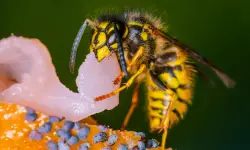Stink bugs are some of the most curious and misunderstood insects in the natural world. Known for the strong odor they release when disturbed, these shield-shaped bugs play a surprisingly complex role in the environment. Their diet varies widely depending on species and habitat, making them both beneficial and sometimes troublesome to humans.
While most people know stink bugs as garden pests, not all of them cause harm. Some feed on plants and crops, while others are predatory and help control pest populations. This diversity makes their feeding habits an interesting study of adaptation and survival.
Understanding what stink bugs eat is key to managing their presence in gardens and agricultural areas. Whether you’re a gardener, farmer, or just curious about these resilient insects, learning about their food preferences reveals how they fit into the ecosystem.
Understanding the Stink Bug Diet

The Feeding Behavior of Stink Bugs
Stink bugs are part of the family Pentatomidae, and their most defining feature is their piercing-sucking mouthpart called a proboscis. Unlike chewing insects, stink bugs insert their proboscis into plants, fruits, or even other insects to extract juices. This specialized feeding method allows them to consume both plant sap and animal fluids, depending on their species.
Most stink bugs are herbivores, feeding primarily on plants, fruits, and seeds. However, some species, like the spined soldier bug (Podisus maculiventris), are carnivorous and prey on caterpillars, beetle larvae, and other soft-bodied insects. This variation makes stink bugs one of the most adaptable insect families on Earth.
What Nutrients Do Stink Bugs Need?
Herbivorous stink bugs feed on carbohydrates, sugars, and plant sap for energy. These nutrients help sustain their metabolism, reproduction, and flight activity. Predatory species, meanwhile, rely on protein and fats from their prey, supporting stronger exoskeletons and faster development.
Moisture is also essential. Stink bugs often feed on juicy fruits or tender plants to stay hydrated. In dry climates, they can extract water directly from their food through specialized glands in their mouthparts.
Why Their Diet Matters to Ecosystems
In small numbers, stink bugs contribute positively to ecosystems. They help break down plant matter and can even control harmful pests. However, when populations grow unchecked, plant-feeding species can damage crops, fruits, and ornamental plants.
Understanding their diet helps gardeners and farmers implement natural control methods — like encouraging predators or managing plant diversity — rather than relying solely on pesticides.
20 Foods Stink Bugs Love the Most
1. Tomatoes
Tomatoes are one of the stink bug’s all-time favorite foods. Their soft, juicy skin is easy to pierce with the bug’s needle-like mouthparts, allowing them to extract the rich plant juices inside. Stink bugs are most active during warm weather, often clustering around tomato vines when the fruit begins to ripen.
These insects feed on the internal fluids of tomatoes, leaving behind pale or yellowish spots surrounded by sunken areas. Their saliva alters the fruit’s texture and stops it from ripening evenly, leading to discolored patches or a spongy feel under the skin.
In agricultural settings, tomato damage caused by stink bugs can greatly reduce market value. Farmers often report significant yield losses during late summer when these pests reach peak populations.
2. Peaches
Peaches are irresistible to stink bugs because of their sweetness and delicate skin. The bugs puncture the outer layer to reach the sugary flesh within, feeding on both sap and juice. Their feeding sites often appear as small, sunken spots that distort the fruit’s shape.
As they inject digestive enzymes, stink bugs cause a type of scarring known as “catfacing,” which makes peaches look blemished and rough. These marks make the fruit less appealing for sale, even though the inner flesh remains edible.
Peach orchards located near wooded areas face recurring infestations since these bugs migrate from natural habitats to cultivated fields once fruit begins to mature.
3. Apples
Apples offer a nutritious and hydrating meal for stink bugs. They’re abundant, long-lasting, and available through several growing stages, providing food for both nymphs and adults. The insects pierce the apple skin and extract sap directly from the fruit tissues.
This process creates dark, pitted marks where cells have collapsed due to feeding. Over time, these spots turn corky and may cause the fruit to deform. In large numbers, stink bugs can severely affect both quality and yield.
Because apple trees produce fruit across multiple months, they serve as an ongoing feeding site, particularly during the bug’s reproductive season in late summer and early fall.
4. Corn
Corn is a staple crop that attracts stink bugs during its early development stages. They feed on stems, leaves, and especially young ears, puncturing kernels to suck out the milky liquid inside. This disrupts kernel growth and leads to misshapen or poorly filled ears.
Feeding activity on corn leaves can also stunt overall plant growth, as the sap extracted contains essential nutrients needed for development. The damage is often most visible during the tasseling and silking phases.
Corn fields adjacent to forests or meadows are more vulnerable because stink bugs overwinter in leaf litter and migrate to crops when temperatures rise.
5. Soybeans
Soybean pods are a preferred target for brown marmorated stink bugs. The insects pierce the pod surface and feed on the liquid within developing seeds, depriving them of nutrients and moisture.
This causes beans to shrivel, discolor, or develop sunken areas known as “stay-green syndrome,” where pods remain green and fail to mature properly. Such feeding also introduces fungal spores, worsening crop damage.
Monitoring stink bug populations is essential during pod formation since unchecked infestations can reduce both seed quality and overall yield.
6. Berries
Berries such as blackberries, raspberries, and strawberries are easy meals for stink bugs thanks to their soft, thin skins. These fruits are loaded with natural sugars and water, making them ideal for quick hydration and energy.
The bugs typically attack fully ripened or overripe berries, leaving behind small, discolored puncture marks. The affected areas often collapse, creating a bruised look that shortens shelf life.
For fruit growers, berry damage is particularly costly because even minor blemishes can downgrade produce from fresh-market quality to processing grade.
7. Grapes
Grapes are another high-sugar food source favored by stink bugs. They feed on both individual grapes and entire clusters, especially as harvest approaches. The punctures left behind promote fungal infections and rot.
Wineries are especially affected, since crushed stink bugs can release their defensive odor into grape juice, spoiling the flavor and aroma of the final product.
Vineyards located near wooded habitats often see seasonal infestations, as stink bugs migrate from natural vegetation in late summer seeking ripe fruit.
8. Beans
From green beans to lima beans, these legumes are prime feeding spots for stink bugs. The insects pierce the pod walls to suck out the developing seeds inside, leaving discolored scars and flattened beans.
Stink bug saliva interferes with normal pod development, leading to curled or malformed pods. Heavy infestations can cause up to 30% yield loss in small-scale farms.
Because beans grow in dense foliage, they provide both food and shelter, making them ideal breeding grounds for stink bugs throughout the warm season.
9. Peppers
Peppers, both sweet and hot varieties, are frequent targets. Stink bugs puncture the skin to draw out internal fluids, leaving behind pale, circular feeding spots. These marks often turn into sunken, corky scars as the fruit matures.
Feeding activity can lead to deformities and uneven ripening. In some cases, the internal tissues under the feeding sites become dry and tasteless.
Peppers grown in humid climates are especially vulnerable, as the moisture promotes rapid bug population growth and longer feeding periods.
10. Okra
Okra pods are tender and full of nutrient-rich sap, making them perfect for stink bug feeding. The bugs pierce the outer surface and drain the inner fluids, causing pods to bend or twist abnormally.
The affected pods often show small brown punctures or roughened areas where feeding occurred. Continued attacks stunt plant growth and reduce overall pod production.
Gardeners can prevent heavy infestations by inspecting plants regularly and removing weeds that serve as alternative food sources.
11. Cotton
Cotton fields attract stink bugs during the plant’s flowering and boll-forming stages. They feed on developing seeds inside the bolls, damaging both the seeds and surrounding fibers.
This feeding leads to seed discoloration, lint staining, and reduced fiber quality, making cotton less valuable. Large infestations can devastate entire harvests if not managed early.
Stink bugs thrive in cotton-growing regions due to the plant’s extended growth period and nutrient-rich seed tissues.
12. Tree Nuts
Pecans, almonds, and hazelnuts are vulnerable when the shells are still soft. Stink bugs pierce the husk to feed on the developing kernels, causing them to shrivel or rot from inside.
This feeding often leads to “kernel necrosis,” where the interior turns black and bitter. The damage is typically not visible until harvest.
Nut orchards near natural vegetation are at greater risk because stink bugs move freely between wild and cultivated food sources.
13. Citrus Fruits
Citrus fruits like oranges and lemons provide moisture and sugars, especially in dry conditions. Stink bugs puncture the peel to extract juice, leaving small, discolored dimples.
Feeding damage may cause uneven coloring or premature fruit drop, reducing overall yield. The puncture wounds also expose the fruit to mold and bacteria.
Although not a primary food source, citrus serves as an occasional meal for stink bugs in warm coastal areas.
14. Cucumbers
Cucumbers attract stink bugs for their tender vines and watery fruit. The bugs feed by inserting their proboscis into the fruit, sucking out sap and cellular fluids.
This feeding causes blemishes, scarring, and distortion of the fruit’s shape. The internal tissue may also turn pale and soft.
Regular weeding and good airflow around cucumber beds help reduce infestation by limiting hiding spots and excess humidity.
15. Eggplants
Eggplants are an appealing food due to their smooth surface and high water content. Stink bugs puncture the skin and feed on the flesh beneath, leaving visible scars or blotchy patches.
These feeding sites may harden over time, making the fruit less attractive for consumption or sale. In severe cases, eggplants become misshapen and lose flavor.
Gardeners often protect plants using lightweight row covers or beneficial insects that prey on stink bug nymphs.
16. Weeds and Wild Plants
When crops aren’t available, stink bugs feed on weeds and wild plants like pigweed, goldenrod, and wild mustard. These plants sustain populations through the off-season.
They provide nourishment and breeding grounds until cultivated crops are ready for feeding again. This allows stink bugs to survive year-round in mild climates.
Clearing weeds from field borders is one of the most effective ways to prevent seasonal infestations.
17. Seeds
Developing seeds offer a concentrated source of nutrients for stink bugs. They pierce pods or fruits to extract the fluid from immature seeds, rich in oils and proteins.
Seed-feeding is especially damaging in soybeans, cotton, and legumes, where yield depends heavily on seed quality.
By reducing seed viability, stink bugs indirectly impact future plant reproduction and agricultural productivity.
18. Sap from Trees
Stink bugs often feed on tree sap, especially from fruit and ornamental trees. They target young shoots and stems, drawing out sugary sap for hydration.
This can cause wilting or leaf drop in heavily infested trees. Over time, the loss of sap weakens plant vigor and growth.
Trees near gardens or orchards may serve as bridges for stink bugs moving between wild habitats and cultivated areas.
19. Insects (Predatory Species)
Predatory stink bugs, unlike their plant-feeding relatives, hunt live prey such as caterpillars, beetle larvae, and aphids. They inject digestive enzymes that dissolve the prey’s tissues before sucking them out.
This feeding behavior provides high-protein nourishment that supports rapid growth and reproduction.
Beneficial predatory species are valuable allies in agriculture, helping naturally control pest populations without chemical pesticides.
20. Fallen or Overripe Fruit
Fallen fruit, whether apples, peaches, or berries, becomes an easy target for stink bugs. The decaying, sugary pulp offers both hydration and calories with minimal effort.
These insects gather under fruit trees or compost piles to feed on fermenting matter, especially in late summer. The scent of overripe fruit attracts large groups quickly.
Although this behavior aids in natural decomposition, it can increase local populations, leading to greater crop pressure in the following season.
FAQs About What Stink Bugs Eat
Do Stink Bugs Eat Plants or Insects?
Both — most are plant feeders, but some species are predatory and consume other insects.
Are Stink Bugs Harmful to Crops?
Yes, plant-feeding species can damage fruits, vegetables, and grains by piercing and sucking juices.
Do Stink Bugs Eat at Night?
They’re mostly active during the day but may feed at night in warm climates.
What Attracts Stink Bugs to My Garden?
Moisture, ripe fruits, and leafy vegetation provide both food and shelter.
Do Stink Bugs Eat Human Food?
Not typically. They’re more interested in plants, though they may invade homes seeking warmth.
Can Stink Bugs Survive Without Food?
Yes, adults can survive several weeks without feeding, especially during overwintering.
Are Stink Bugs Good for the Environment?
Predatory species are beneficial, but plant-feeding species can be pests in large numbers.
What Do Baby Stink Bugs Eat?
Nymphs feed on the same foods as adults — plant sap, fruits, or small insects, depending on their species.
Do Stink Bugs Drink Water?
They obtain moisture directly from their food, especially from juicy fruits and plants.
How Can I Reduce Stink Bug Feeding Damage?
Plant trap crops, remove weeds, and encourage natural predators like spiders and birds.
Final Thoughts
Stink bugs may not be the most welcome guests in a garden, but their diverse diet reveals just how adaptable they are. From fruits and vegetables to seeds and even other insects, these resilient creatures can thrive in almost any environment.
Understanding what stink bugs eat helps farmers and gardeners strike a balance between control and coexistence. By learning their habits, we can protect crops while respecting their place in the ecosystem — as both pests and participants in nature’s complex food web.






